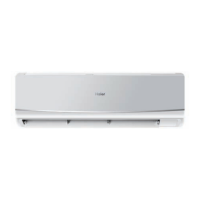What to do if the fuse on PC board is broken in Haier Air Conditioner?
- DDavid CollinsAug 5, 2025
If the fuse on the PC board of your Haier Air Conditioner is broken, replace it with a fuse of type T. 3.15A/250V.

What to do if the fuse on PC board is broken in Haier Air Conditioner?
If the fuse on the PC board of your Haier Air Conditioner is broken, replace it with a fuse of type T. 3.15A/250V.
What to do if the supply cord of Haier Air Conditioner is damaged?
If the supply cord of your Haier Air Conditioner is damaged, it must be replaced by the manufacturer, its service agent, or a similarly qualified person.
| Cooling Capacity | 7000 BTU/h |
|---|---|
| Power Supply | 220-240V, 50Hz |
| Refrigerant | R22 |
| Weight (Indoor Unit) | 8 kg |
| Power Consumption (Cooling) | 650 W |
| Noise Level (Indoor) | 34 dB(A) |
| Type | Split |
Read this manual carefully to diagnose trouble correctly before offering service.
Highlights key operational advantages: wide-angle airflow, air purifying, quiet operation, and energy efficiency.
Details cooling/heating capacity, power, EER, COP, air volume, and power requirements.
Manual intended for authorized servicers familiar with tools and terminology for troubleshooting and repair.
Provides critical safety warnings regarding electrical shock, grounding, and heat exposure during servicing.
Details the acceptable indoor and outdoor temperature ranges for cooling and heating operations.
Lists essential safety guidelines for appliance usage, installation, and disposal.
Identifies and explains the function of key indoor unit parts like inlet grille, air filter, and indicators.
Lists various Haier air conditioner models supported by this manual.
Explains the functions of each button and display element on the remote controller.
Provides step-by-step instructions for setting the clock on the remote controller.
Details the remote controller layout and functions for units equipped with a health operation feature.
Explains the anion generator's role in purifying air and its benefits for room environment.
Covers proper usage, signal transmission, and handling precautions for the remote controller.
Instructions for loading batteries, confirmation indicators, and using the reset key.
Explains how the unit resumes operation after a power interruption and related precautions.
Details how to start the unit and select operation modes like AUTO, COOL, DRY, HEAT, and FAN.
Explains how to adjust fan speed through the FAN button (AUTO, LO, MED, HI).
Describes how to stop the unit and what happens to the display and indicators.
Covers selecting COOL, HEAT, DRY modes and adjusting the temperature setting.
Details how to select fan speed for different operating modes.
Explains how to adjust vertical airflow direction using the remote controller and potential issues.
Describes manual adjustment of horizontal airflow direction and cautions related to condensate water.
Details the unit stop procedure and provides cautions for COOL/DRY modes and system protection.
Covers selecting and setting TIMER ON, TIMER OFF, and TIMER ON-OFF modes.
Explains how to confirm the set timer, indicated by the timer mode indicator.
Instructions on how to cancel an active timer setting.
Detailed steps for setting the timer to turn the unit ON at a specific time.
Detailed steps for setting the timer to turn the unit OFF at a specific time.
Procedure for operating the unit when the remote controller is defective or lost.
Guidance on using the test operation switch for initial checks, especially in low temperatures.
How to disable emergency or test operation modes.
Explains how the unit adjusts temperature automatically for comfortable sleep in cooling mode.
Details the temperature adjustments for comfortable sleep in heating mode.
Information on power resume function and notes on sleep mode applicability in AUTO/FAN modes.
Instructions for cleaning the exterior of the air conditioner unit and its remote controller.
Step-by-step guide on how to remove, clean, and reattach the air filter.
Provides advice on room temperature, closing windows, filter cleaning, and timer usage for efficiency.
Lists essential 'do nots' like sprinkling water, blocking airflow, pulling plugs, or misusing the unit.
Introduction to control functions, automatic running, and mode switching based on temperature.
Details indoor temperature control logic and operation patterns for dehumidification.
Covers warm start, fan control, defrosting, freezing prevention, and overload protection in heating modes.
Explains trial run, emergency run, temperature compensation, and sleep function operations.
Addresses common phenomena like non-restart, noise, smells, and mist/steam blown out.
Guides troubleshooting for issues like unit not working, poor cooling, and applicable temperature ranges.
Diagnoses problems with remote control, outdoor fan motor, and indoor fan motor operation.
Troubleshooting for units not heating or not cooling, checking PC boards and valve coils.
Diagnoses issues with indoor unit water drainage and compressor not working.
Troubleshooting for outdoor fan motor running but compressor not, or both not running.
Diagnoses failure to heat, error codes E8, F11, and related component checks.
Overview of the installation manual, necessary tools, accessory parts, and installation drawings.
Guidelines for fixing the outdoor unit and selecting its installation place.
Criteria for selecting the appropriate installation location for the indoor unit.
Requirements for power source connection and selection of piping materials.
Steps for fitting the mounting plate and determining the wall hole location for the indoor unit.
Instructions for making the wall hole and fitting the piping hole cover.
Guides drawing pipes, inserting drain hose, and connecting heat insulation for indoor unit installation.
Procedure for securely hanging and fixing the indoor unit body onto the mounting plate.
Steps for removing the wiring cover and connecting the indoor and outdoor electric cables.
Specific instructions for connecting cables before and after indoor unit installation, including terminal checks.
Presents detailed wiring diagrams for different models and important notes.
Instructions for connecting pipes to the outdoor unit, including bending, torque, and length considerations.
Guidance on connecting electrical terminals and attaching the drain-elbow.
Detailed procedure for using a vacuum pump to purge refrigerant lines and check for gas leakage.
Instructions for cutting and flaring pipes correctly, with examples of good and bad practices.
Guidelines for proper drain hose installation and applying heat insulation.
Checklist for verifying correct installation and performing initial operational tests.
Presents the internal wiring schematic for the indoor unit, including components and connections.
Illustrates the wiring schematic for the outdoor unit, showing compressor, fan motor, and valve connections.












